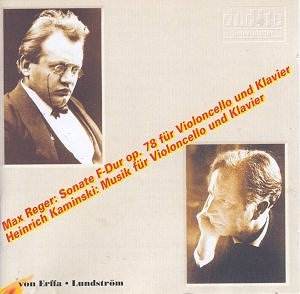While
Reger is well enough known to have a whole case of hand-me-down
judgements ready to despatch his music, Kaminski is completely
unheard of. His exposure has been very limited which makes this
CD all the more valuable. Ulrike Kienzle sketches in the details.
Kaminski lived near Benediktbeuren (the home of the Carmina
Burana originals) in the house of his friend Franz Marc. Marc
was an expressionist painter killed in the Great War. Kaminski
was a friend of Walter Braunfels (a more prominent name in the
miscellaneous Entartete group). Kaminski was a pacifist
and made no secret of his condemnation of Nazi policy.
The
Music for Cello and Piano while studiously avoiding the
word ‘Sonata’ has the 'feel' and 'contour' of a sonata. It is
unrelentingly serious, devotedly tonal and threaded through and
through with Bachian touches. The central 'Tanz' movement is alive
with fugal material and with a Jacques Loussier-style endowed
with a devotional sense. The cello is apt to sound inward and
prayerful and Kaminski is happy to go with the character and grain
of the instrument. The work picks up shards of Viennese waltz
elements in the finale. The central movement's dance elements
bear no resemblance to Weill, Stanchinsky or Kapustin. Here the
dance is a religious rite - blessed as the bowed head and the
murmured prayer. This is a satisfying work though the performance
does sometimes make it sound strenuous and effortful. The work's
style-parallels include the John Foulds Cello Sonata (1905) soon
to have a new recording by the redoubtable cellist Michael Schlechtriem.
After
two Brahmsian cello sonatas Reger's F major work was
to strike a more individual note. It belongs to his Munich years
when recently married he felt the confidence to strike out in
newer directions. There are four movements: a stormy allegro
con brio with Tchaikovskian drama; a playful, almost jokey,
Vivacissimo, superbly carried off by Lundström and
rounded off with a masterly sigh; an andante with variations
and a vivacious finale in which there are Brahmsian suggestions
[3.19, 5.21] as well as Slavonic tempests.
These
are two intriguing German cello sonatas from composers at ease
in the realms of tonality. They are performed with dedication
though I wonder whether the Kaminski (possibly an awkward work
to perform) might go more fluently in other hands.
Rob
Barnett
